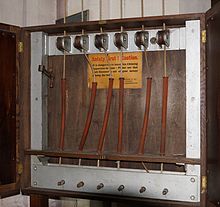


The Ellacombe apparatus is a mechanism devised for performing change ringingonchurch bells by striking stationary bells with hammers. However it does not have the same sound as full circle ringing due to the absence of doppler effect as the bells do not rotate and the lack of a damping effect of the clapper after each strike.
It requires only one person to operate, unlike the traditional method, where the bells are rotated through over 360 degrees (full circle ringing) to sound them and one person is needed for each bell. Instead the bells are kept static (or "hung dead") and a hammer is struck against the inside of the bell. Each hammer is connected by a rope to a fixed frame in the bell-ringing room. When in use the ropes are taut, and pulling one of the ropes towards the player will strike the hammer against the bell. For normal full circle ringing, the ropes are slackened to allow the hammers to drop away from the moving bells.
The system was devised by Reverend Henry Thomas Ellacombe of Gloucestershire, who first had such a system installed in Bitton in 1821. He created the system to make conventional bell-ringers redundant, so churches did not have to tolerate the behaviour of what he thought were unruly bell-ringers. The Revd Ellacombe was the editor of the bell ringing column of a church periodical called "Church Bells", and was not slow to criticise the actions of bell ringers who did not ring exclusively for church services. A particular target was "prize ringing", where teams from different churches competed for a prize for the best ringing, usually accompanied by a social event. An example was in 1875 when he weighed in with a diatribe against a ringing competition at Slapton in Devon, when he wrote, "We blame the Vicar and churchwardens for allowing the bells to be so prostituted for the benefits of a publican's pocket...".[1]
However in reality, it required very advanced and rare expertise for one person to ring changes, which most churches did not have and it alienated bell ringers from the church. The sound of a chime was a feeble substitute for the rich sound of swinging bells, and the apparatus fell out of fashion. Consequently the Ellacombe apparatus has been removed from many towers in the UK, but there are still visible holes in the ceiling which the ropes would come through into the ringing chamber, and often the frames are still in the ringing chamber, without ropes.
In towers where the apparatus remains intact, it is generally used like a Carillon, but to play only simple tunes, as a real carillon has at least 23 bells, which are played serially to produce a melody, or sounded together to play a chord.
This list is not exhaustive.
St Giles Curch, Desborough, Northamptonshire